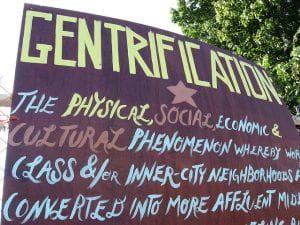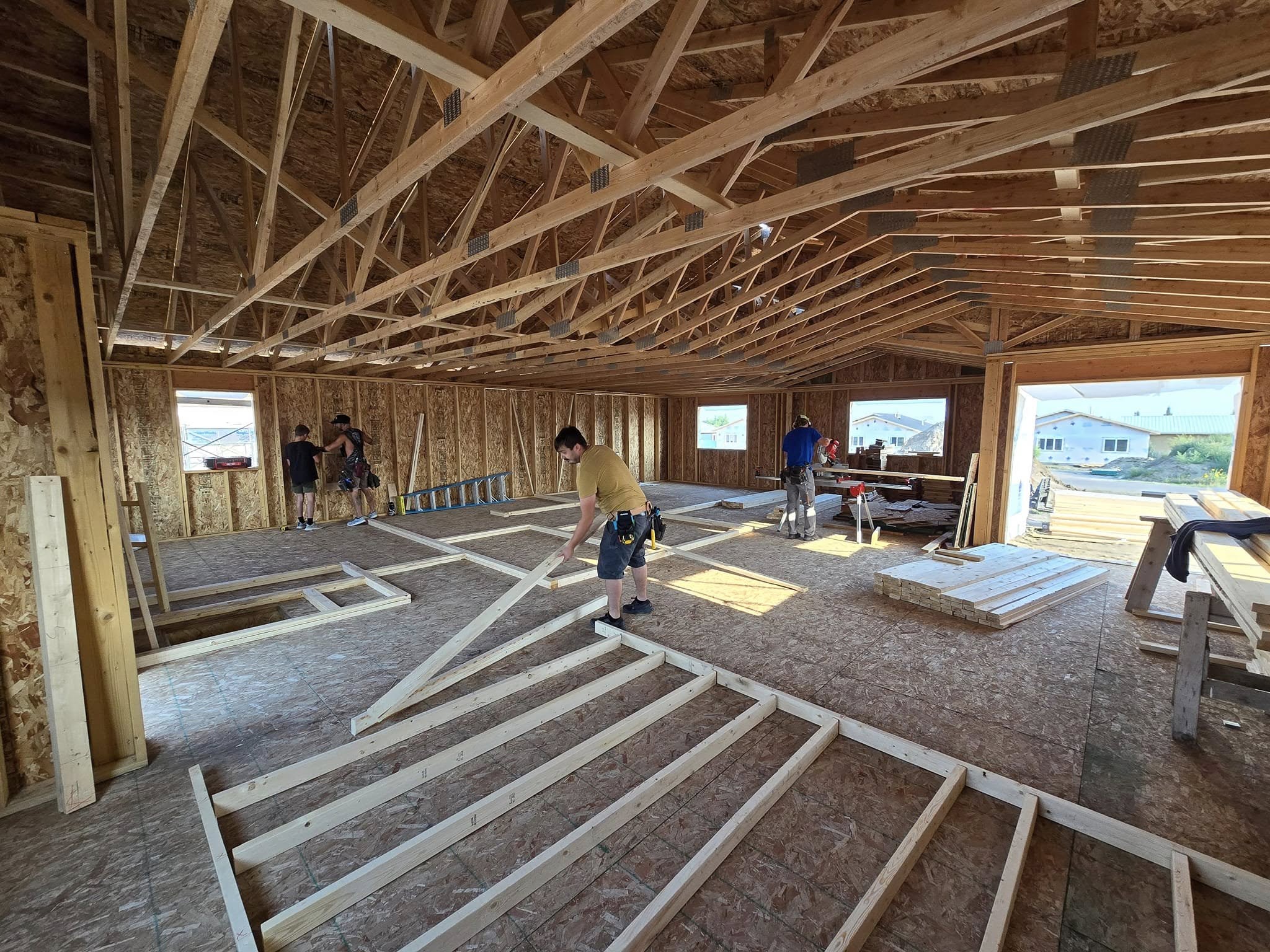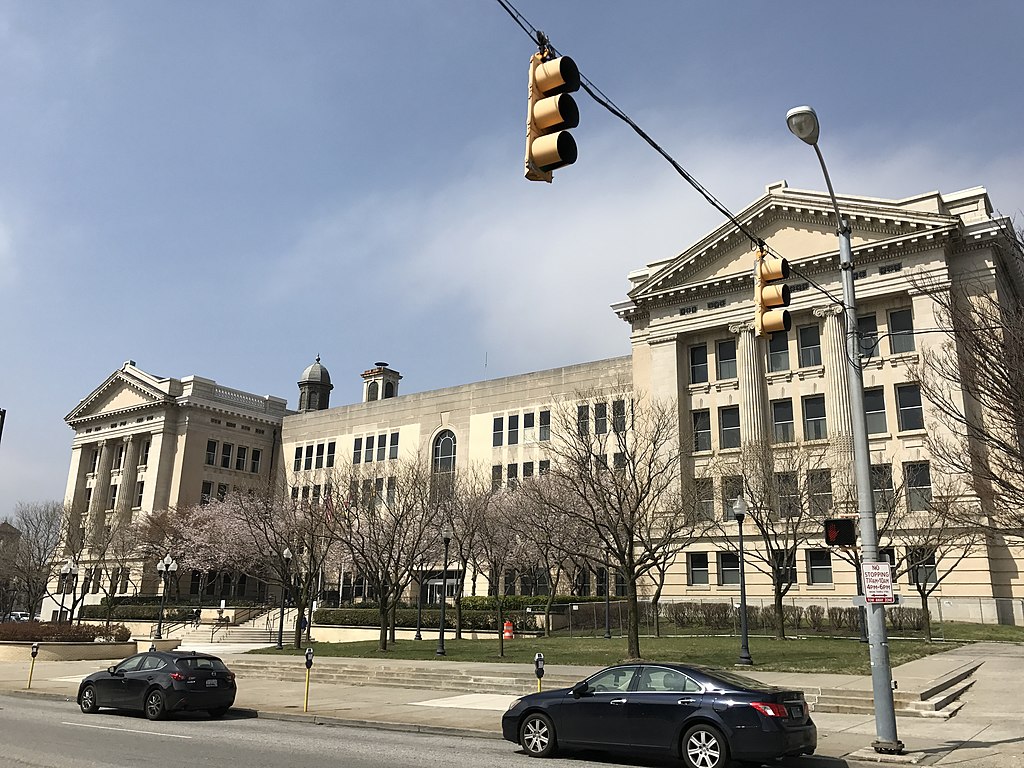
Photo by Abbey Hambright via flickr, CC BY-NC-ND 2.0.
Does this sound familiar? A persistently poor, highly distressed, and long-screwed-over neighborhood is organizing around, lobbying for, or about to get some kind of reinvestment and someone raises the specter of gentrification. Those supporting the reinvestment get frustrated and say something along the lines of “Are you kidding? This place will never gentrify!” or “We could use some gentrification here.”
I think this particular exchange is one we should all commit to never having again.
Why You’re Both Right About Gentrification
Those who dismiss concerns of gentrification have some data behind them. Rapid housing cost appreciation and demographic turnover is a very real and growing problem, but it is still concentrated in a few high-cost markets, and a few select neighborhoods of other cities. Most poor census tracts have stayed stubbornly poor for decades, and more have slipped into poverty recently than climbed out of it.
Housing affordability and displacement are actually problems everywhere, but in most places it’s not due to gentrification. Many of the people who are frustrated when gentrification is brought up see the topic as part of a coastal/hot-market narrative that leaves their places out, and gives them policies that aren’t relevant for their realities—like hot-market centric inclusionary housing policies or funding models that don’t account for an appraisal gap. They worry that the very real, current needs of places being left behind are going to be sacrificed by fear of some unlikely future scenario.
[RELATED ARTICLE: What Does ‘Gentrification’ Really Mean?]
Those who raise the concern also have a point, though. First, we should all remember that in the 1970s, the idea that New York City—especially the Bronx and much of Brooklyn—would gentrify was laughable. Or Hoboken and Jersey City. Ditto, more recently, for some of the spots where public housing was torn down in Chicago. Trends and markets change, so saying “that will never happen” is both ahistorical and unprovable, and sounds dismissive and insensitive in a world where urban renewal is in living memory and things like increased calls to police in gentrifying neighborhoods can literally be a matter of life and death.
Second, there can be legitimate things people worry about that get lumped under “gentrification,” even if an area does not strictly gentrify in the sense of rapid property value appreciation that displaces existing residents—affluent people moving in, racial demographic change, and cultural change in who is served by retail and others institutions. Even without that perfect storm, reinvestment projects can still be done in a non-equitable fashion, displace people, and prioritize the needs of newcomers or outsiders over current residents. Those are very real problems, and likely underlie many of the concerns raised.
Sound and Fury
Here’s the thing—we don’t have to answer this question. If you’re talking about a location that is not in imminent danger of rapid appreciation, it doesn’t matter whether the likelihood in 20 years is 0 percent, 30 percent, or 60 percent.
The principles of equitable development are the same in either case. A stable, equitable, inclusive community is going to be both less available for rapid, disruptive gentrification and better prepared to mitigate it if it comes calling. This means we can invest to improve conditions now and ready ourselves for what’s to come at the same time.
*Caveat*—I can’t say too often—it is important to identify neighborhoods that are at imminent, short-term risk of gentrification. Those neighborhoods should get special attention and some additional policy interventions as compared to those where any potential may-or-may-not happen gentrification is further off. Many places are working on tools to identify these short-term risk factors. I’m talking here about places where there are no notable current pressures, which is where the above exchanges often happen.
As Rick Jacobus writes, in “It’s Not Either/Or: Neighborhood Improvement Can Prevent Gentrification”: “While it is common to worry about gentrification whenever rents rise, gentrification seems to happen most dramatically in neighborhoods where rents fall creating an opportunity for speculators to ‘flip’ an area. While it sometimes happens that more moderate- and mixed-income, working-class neighborhoods become ‘hip,’ it is far less common because middle-income families simply outbid the speculators and hipsters that form the leading wedge of gentrification. So for a lower-income community, ‘improvements’ that make the place more attractive to slightly higher-income households may actually provide the most promising defense against gentrification.”
A Foundation of Equitable Development
Here are some examples of the kind of backbone measures that will benefit a neighborhood whether it ever faces rapid appreciation and lots of in-movers. They will probably sound familiar.
- Take housing and other land out of the speculative market. There’s plenty of money being made by speculators in distressed neighborhoods, they’re just doing it differently. When a market isn’t hot is a perfect time to acquire land and establish entities like community land trusts, limited-equity co-ops, and other publicly or collectively controlled amenities, like green space. If market pressures rise, that percentage held back from speculation will protect those who live in them and maintain a space for lower-income residents in the area long term, and if extensive enough may moderate the extent to which the market can explode. If market pressures don’t rise, the community stewardship of that land has still provided security and stability, greater access to homeownership, and fostered community and collective efficacy. As Randy Shaw says, quoted by Rick Jacobus in “The Gentrification Vaccine,” “It’s hard to gentrify a neighborhood when a major portion of its land isn’t available to speculators.” Along with allowing people of different incomes a place to stay, Jacobus continued, “The presence of permanently affordable housing units at this scale may be enough to permanently constrain the character of any market-rate housing in the area. You can only go so far upscale in this context.”
- Tenant protections and support. Though their nature might differ somewhat, evictions and tenant displacement are high in both distressed markets and hot markets. Tenant protections such as just-cause eviction, right to counsel in housing court, anti-harassment laws, and emergency rental assistance will benefit a neighborhood whether its main landlord challenge is milkers or flippers.
- Support sustainable homeownership for those who are already attached to the neighborhood. Whether it’s through limited-equity co-ops, community land trusts, or traditional homeownership done right (with things like safe loans, repair support, and protection against equity-stripping products), helping current residents and those with social ties to the area who want to purchase homes in the neighborhood now can be a bulwark against disruptive speculation.
- Help culturally important institutions and small businesses own their own buildings.
- Focus investment toward projects that serve people in the neighborhood or connected to it. Projects that improve the quality of life for existing residents (adding essential retail, giving the teens a place to go, reconfiguring bus routes to connect people to jobs) will also attract others who can contribute to the neighborhood’s healthy development, as opposed to projects that are focused on appealing to outsiders.
- Build power among the vulnerable and marginalized. This is key, of course. People who have an organized voice, and are following policy and planning decisions can advocate for more resources to a place that’s not getting enough, or point out warning signs like condo conversions or aggressive cash buyers that call for a new wave of policies. Speaking of which. . .
Bonus item—Watch benchmarks. Especially if there’s serious disagreement about whether gentrification might actually be imminent, a well-organized community can look at their risk factors and agree on certain measures (such as property value rises, rent increases, increase in absentee ownership) that would indicate it’s time to re-evaluate strategy and address gentrification as a more short-term threat (but still before it arrives).
This is not a comprehensive list by far. The point is there are many things that can be done without answering the question of what the market will do in the long term, things that will advance equitable development either way. But we’ll be able to pull them off better working together, not fighting over a fraught word and unprovable assertions. And so I would like to suggest that as much as possible we all refrain from debating the long-term likelihood of gentrification in a particular distressed place. Don’t insist it won’t happen. Don’t insist it will. Keep an eye on the data, but focus on building equitable, healthy communities now.




The dialogue about gentrification will never evolve as long as articles like this one continue to use “gentrification” as if it were synonymous with “revitalization”. Excessive gentrification is revitalization done badly.
Amen and I love your name.
Not really. “A little” gentrication is good only SOUNDS good. Not in.reality. Developers will never stop once developers have a foot in the door. With the prospect of millions in profit, they will then by hook and crook, gentrify ike a steamroller,.displacing everything in their way, buying off tenants and politicians, threatening eviction, and much.more. It will go on and on. It is a Pandora’s box. Their lawyers will know all the loopholes and use them Then they will lie about what the law says even in court, and the judges, not expert in housing law, take them at their word. It happened here in DC, a good Google search will bring it up. Take it from someone who is a tenant advocate who has seen developers at work for 15 years.
No where in the above article does it say “a little gentrification” was a good thing.
Nor did I in any way equate gentrification with revitalization—Storm, you’re the one doing that. The point of much of the above is that equitable revitalization protects against gentrification.
The point was that you can do what needs doing now without settling the argument with others about if/when gentrification will come.
Please read again!
This is the best resource I’ve seen for giving advocates, developers and organizers a clear perspective on and approach to gentrification. Thank you ShelterForce and Miriam Axel-Lute